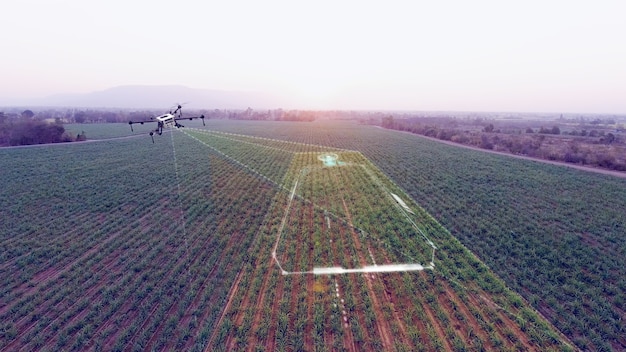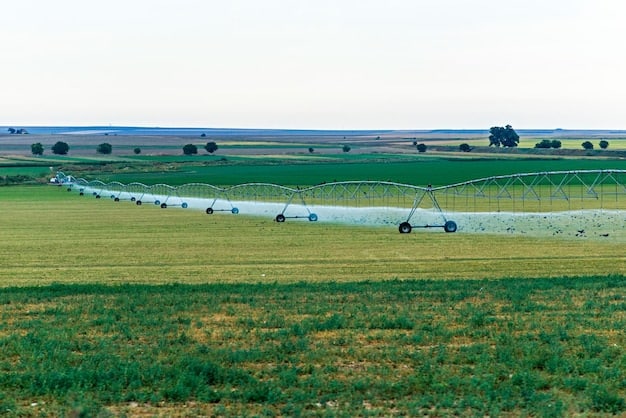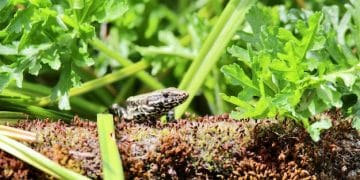Precision Agriculture: Boosting Yields, Saving Earth

Advertisements
Precision agriculture stands as a transformative approach, leveraging cutting-edge technology and data analytics to optimize crop production and increase yields by up to 20%, concurrently minimizing environmental impact through efficient resource management.
Advertisements
In a world grappling with food security concerns and environmental degradation, the promise of
The Future of Farming: How Precision Agriculture Can Increase Crop Yields by 20% While Reducing Environmental Impact is not merely a scientific aspiration but a global necessity. This innovative paradigm redefines agricultural practices, moving from traditional, broad-stroke methods to highly targeted, data-driven interventions. It represents a critical shift towards sustainable food production, offering a dual benefit: enhancing productivity while safeguarding our planet.
Advertisements
Understanding the Core of Precision Agriculture
Precision agriculture, often referred to as satellite farming or site-specific crop management, is a farming management concept based on observing, measuring, and responding to inter- and intra-field variability in crops. Its fundamental premise is that different parts of a field require different types and amounts of inputs, a stark contrast to the uniform application often employed in conventional farming.
This approach harnesses a suite of technologies to achieve a more efficient and sustainable farming system. It moves beyond the traditional one-size-fits-all method, recognizing the inherent variability within a single field. By tailoring practices to specific needs, farmers can optimize resource use, leading to enhanced productivity and reduced waste. The beauty of precision agriculture lies in its ability to transform raw data into actionable insights, empowering farmers to make more informed decisions.
The Shift from Conventional to Precision
Historically, agricultural practices have relied on generalized guidelines for entire fields, sometimes even entire regions. This often resulted in over-application or under-application of resources like water, fertilizers, and pesticides, leading to inefficiencies and environmental concerns.
- Conventional Farming: Employs uniform application of inputs across fields, often based on broad averages or empirical knowledge.
- Precision Agriculture: Utilizes data-driven insights to apply exact quantities of inputs at precise locations, optimizing for specific plant and soil needs.
The transition to precision agriculture is not just about adopting new tools; it’s about embracing a new philosophy of farming. It’s about seeing the field not as a uniform entity, but as a collection of diverse micro-environments, each with its own unique requirements. This nuanced understanding is what allows for the significant improvements in yield and environmental footprint.
Key Technological Pillars
The practical application of precision agriculture relies heavily on several interconnected technologies that gather, process, and act upon data:
- GPS and GNSS: Global Positioning System and Global Navigation Satellite System provide accurate location data for mapping fields, guiding machinery, and tracking operations.
- Sensors: A variety of sensors, both ground-based and aerial (e.g., drones, satellites), collect data on soil properties, plant health, moisture levels, and pest infestations.
- Variable Rate Technology (VRT): This allows for the precise application of inputs like seeds, fertilizers, and pesticides, adjusting rates based on real-time data and prescription maps.
- Geographic Information Systems (GIS): GIS software integrates, stores, edits, analyzes, and displays geographically referenced information, enabling the creation of detailed field maps.
These technologies work in concert to create a comprehensive picture of the agricultural landscape. From initial data collection to final implementation, each component plays a vital role in ensuring that resources are allocated precisely where they are needed most. The integration of these systems is what truly unlocks the potential of precision agriculture, transforming raw data points into tangible benefits for the farmer and the environment.
In essence, precision agriculture represents a paradigm shift from traditional homogenous farming to a heterogeneous, data-informed approach. This shift promises not only increased economic viability for farmers but also a substantial reduction in the ecological footprint of agriculture, marking a pivotal step towards a more sustainable future for food production.
The Role of Data and Analytics in Boosting Yields
At the heart of precision agriculture’s efficacy lies the sophisticated collection and analysis of data. This “smart farming” approach transforms raw measurements into actionable insights, guiding farmers to make optimal decisions that directly impact crop yields.
The ability to collect vast amounts of granular data is just the first step. The true transformative power comes from the analytical tools and platforms that can process this data, identify patterns, predict outcomes, and generate precise recommendations. This intelligent use of information allows for an unprecedented level of control and efficiency in farming operations.
Collecting Granular Field-Level Data
Modern precision farming leverages diverse sources for data acquisition, capturing minute variations across a field that might otherwise go unnoticed. This granularity is critical for understanding the “story” each part of the field is telling.
- Soil Sensors: Providing real-time data on moisture, nutrient levels, pH, and organic matter content, pinpointing areas of deficiency or excess.
- Drones & Satellite Imagery: Offering high-resolution aerial views to assess plant health, identify disease outbreaks, monitor growth stages, and detect water stress.
- Yield Monitors: Integrated into harvesting equipment, providing precise yield data tied to specific GPS coordinates, creating detailed yield maps.
These data streams, when combined, create a comprehensive digital twin of the farm, enabling farmers to visualize and understand the complex interplay of factors affecting crop growth. This detailed mapping is the foundation upon which all subsequent precision agriculture decisions are built.
The continuous flow of data from these sources allows for dynamic adjustments, rather than static plans. If soil conditions change due to weather or other factors, the system can recommend immediate, targeted interventions, ensuring that crops always receive what they need, when they need it.
Transforming Data into Actionable Insights
Raw data is only as valuable as the insights it can provide. This is where advanced analytics and predictive modeling come into play, translating complex datasets into practical advice for farmers.
- AI & Machine Learning: Algorithms analyze historical and real-time data to predict potential issues like pest outbreaks or water shortages, and recommend preventive measures.
- Prescription Maps: Based on sensor data and analytics, these maps guide variable rate applicators to deliver precise amounts of seeds, fertilizers, or water to specific zones within a field.
- Decision Support Systems: Software platforms integrate various data sources and present farmers with clear recommendations for irrigation scheduling, nutrient application, and pest management.
By leveraging these analytical tools, farmers can move from reactive problem-solving to proactive management. They can anticipate challenges before they escalate and implement solutions with a level of precision previously impossible. This not only saves resources but also significantly enhances the chances of a successful harvest. The intelligence derived from this data is what allows precision agriculture to consistently outperform traditional methods.
Reducing Environmental Impact Through Precision Agriculture
Beyond boosting yields, perhaps the most compelling benefit of precision agriculture is its profound potential to mitigate the environmental footprint of farming. By optimizing resource use, it offers a sustainable pathway to feed a growing global population.
Traditional farming practices often involve the indiscriminate application of inputs, leading to waste and environmental pollution. Precision agriculture, however, champions a “less is more” approach, ensuring that every drop of water, every gram of fertilizer, and every milligram of pesticide is applied with intent and precision, thereby minimizing adverse ecological effects.
Optimizing Water Usage
Water scarcity is a critical global challenge, and agriculture is one of its largest consumers. Precision agriculture offers sophisticated solutions to dramatically reduce water waste.
- Sensor-Based Irrigation: Soil moisture sensors detect the exact water needs of plants in different areas of a field, triggering irrigation only when and where it’s necessary.
- Variable Rate Irrigation (VRI): Allows for custom water application based on soil type, topography, and crop needs, preventing over-watering in some areas and under-watering in others.
- Weather Monitoring: Integrating local weather forecasts helps farmers anticipate rainfall, further optimizing irrigation schedules and preventing unnecessary water application.
By preventing runoff and deep percolation caused by over-irrigation, precision agriculture conserves precious water resources. This efficiency not only saves water but also reduces energy consumption associated with pumping, translating into both environmental and economic benefits. The focus is on delivering the right amount of water at the right time, exactly where it’s needed, eliminating waste.

Minimizing Fertilizer and Pesticide Runoff
Excessive use of fertilizers and pesticides can severely pollute water bodies and harm biodiversity. Precision agriculture employs targeted application, significantly reducing these harmful effects.
- Nutrient Management: Soil testing and mapping identify precise nutrient deficiencies, allowing farmers to apply only the necessary types and amounts of fertilizers, preventing excess nitrogen and phosphorus runoff into waterways.
- Integrated Pest Management (IPM) with Precision Tools: Drones and sensors can pinpoint pest infestations, enabling spot treatment of affected areas rather than broad-spectrum spraying across entire fields. This reduces the overall volume of pesticides used.
The reduction in chemical inputs not only protects ecosystems but also ensures the long-term fertility of the soil and the safety of agricultural products. This responsible use of chemicals aligns perfectly with sustainable farming principles, prioritizing environmental health alongside productivity. It’s about finding the balance between protecting crops and protecting the planet.
In essence, precision agriculture transforms farming into a highly resource-efficient process. By making every input count, it dramatically lessens the ecological footprint of food production, positioning itself as a cornerstone of sustainable development. This balanced approach ensures that agricultural progress does not come at the expense of environmental well-being, paving the way for a healthier planet and more resilient food systems.
Challenges and Barriers to Adoption
Despite the undeniable benefits of precision agriculture, its widespread adoption faces several significant hurdles. These challenges range from economic considerations to technological complexities and human factors, requiring concerted efforts to overcome them.
The transition from conventional farming to a data-driven, technology-intensive system is not straightforward. It demands substantial investment, new skill sets, and a willingness to embrace change, all of which can be daunting for farmers, particularly those operating on thinner margins or in less technologically advanced regions.
High Initial Investment Costs
One of the primary deterrents for farmers, especially small to medium-sized operations, is the substantial upfront cost associated with acquiring the necessary precision agriculture equipment and software.
- Equipment: GPS-guided tractors, drones, sophisticated sensors, and variable rate applicators represent considerable capital expenditures.
- Software & Training: Investment in data analytics platforms and training for farmers and farm workers on how to effectively use these new technologies is also required.
The return on investment (ROI) can take time to materialize, making the initial outlay a risky proposition for many. Government subsidies, loan programs, and shared equipment initiatives could play a crucial role in lowering this barrier, enabling more farmers to access these transformative technologies.
Without adequate financial support and clear demonstrations of long-term profitability, many farmers will understandably hesitate to make such a significant commitment. Addressing the economic feasibility is paramount for broader adoption.
Technical Expertise and Connectivity Issues
The effective implementation of precision agriculture relies on a degree of technical proficiency that many farmers may not possess, as well as robust infrastructure that is often lacking in rural areas.
- Skill Gap: Operating and interpreting data from complex sensors, drones, and software platforms requires specialized knowledge in areas like computer science, data analytics, and agronomy.
- Rural Connectivity: Many agricultural regions lack reliable high-speed internet access, which is essential for transmitting large volumes of data from field sensors to central processing units and cloud-based platforms.
Bridging the skill gap through accessible training programs and improving rural broadband infrastructure are critical steps. Universities, agricultural extension services, and technology providers must collaborate to make precision agriculture less intimidating and more user-friendly for the average farmer. Without these foundational elements, even the most advanced technologies remain inaccessible.
Overcoming these challenges requires a multi-faceted approach involving policy support, technological innovation, and educational initiatives. By making precision agriculture more affordable, user-friendly, and accessible, we can accelerate its adoption and unlock its full potential for sustainable food production on a global scale. This collective effort is crucial for the future of farming.
Case Studies and Success Stories
The theoretical promise of precision agriculture is compelling, but real-world examples truly demonstrate its transformative power. Numerous farms worldwide have successfully integrated these technologies, showcasing tangible improvements in yield and environmental stewardship.
These case studies serve as powerful testimonials, illustrating how farmers of varying scales and across diverse geographies are leveraging data and technology to overcome traditional agricultural challenges. They provide practical insights into the implementation strategies and the remarkable outcomes that are achievable.
Pioneering Farms in the US Midwest
The agricultural heartland of the United States has seen significant adoption of precision farming techniques, particularly among large-scale corn and soybean producers. Their experiences highlight how technology adoption can translate into substantial gains.
- Iowa Corn Farmer: A farmer in Iowa implemented variable rate seeding and fertilization over 1,500 acres. By analyzing yield maps and soil data from previous seasons, they were able to optimize seed populations and nutrient application per zone. The result was an average 7% increase in corn yield across their fields and a 10% reduction in fertilizer costs, leading to a significant boost in profitability and reduced nutrient runoff.
- Nebraska Soybean Operation: Another family farm introduced drone-based imagery for early disease detection and targeted herbicide application. This shift from blanket spraying to spot treatment led to a 15% reduction in herbicide use and, more critically, prevented widespread crop loss in certain areas, safeguarding overall yield.
These examples from the Midwest underscore the economic viability and environmental benefits of adopting precision agriculture. Farmers are increasingly recognizing that the initial investment pays off through higher yields, lower input costs, and a more sustainable farming operation. The systematic collection and analysis of data allow for continuous improvements, turning each season into a learning opportunity.

Global Examples of Impact
Precision agriculture’s impact isn’t limited to large commercial farms in developed nations; it’s increasingly being adapted and applied in diverse agricultural contexts globally.
- Australia’s Wheat Belt: Farmers are using GPS-guided machinery and historical rainfall data to make more accurate planting decisions, optimizing planting patterns to maximize water efficiency in arid conditions. This has led to more consistent yields even during drought periods.
- Smallholder Farms in India: Pilot programs are introducing mobile apps and affordable sensor technologies to advise smallholder farmers on optimal irrigation schedules and nutrient management for rice paddies, leading to water savings and better yields despite limited resources.
These global success stories demonstrate the adaptability and universal potential of precision agriculture. While the scale and specific technologies may vary, the core principle remains the same: using data and precise application to make farming more efficient, productive, and environmentally sound. These examples inspire confidence that precision agriculture is not just a niche practice for the technologically advanced, but a viable solution for feeding the world sustainably.
The lessons learned from these case studies are invaluable. They highlight the importance of tailored solutions, continuous learning, and adapting technology to specific regional and crop needs. As more farmers share their experiences, the path to broader adoption of precision agriculture becomes clearer, paving the way for a more food-secure and environmentally resilient future.
The Regulatory and Policy Landscape
The transformative potential of precision agriculture is clear, but its full realization depends significantly on a supportive regulatory and policy environment. Governments and international bodies play a crucial role in fostering innovation, ensuring responsible implementation, and encouraging widespread adoption.
Policies can either accelerate or impede the progress of precision agriculture. They influence funding for research, infrastructure development, data governance, and the overall economic landscape for farmers. Therefore, understanding and shaping this landscape is vital for the future of farming.
Government Incentives and Subsidies
To encourage farmers to invest in costly precision agriculture technologies, many governments are implementing incentive programs and subsidies.
- Financial Aid: Direct grants, low-interest loans, and tax credits for purchasing precision farming equipment (e.g., GPS systems, drones, VRT applicators).
- Research & Development Funding: Investments in agricultural research institutions to develop new precision farming technologies and best practices.
- Educational Programs: Funding for agricultural extension services and universities to provide training and technical assistance to farmers on precision agriculture implementation.
These financial and educational incentives are critical for reducing the high upfront costs and technical barriers that often deter farmers. By making these technologies more accessible and demonstrating their long-term benefits, governments can significantly accelerate adoption rates and ensure that the benefits of precision agriculture are widely distributed across the agricultural sector.
Moreover, policy support for pilot projects and demonstration farms can provide valuable real-world examples and training grounds, further de-risking the adoption process for hesitant farmers and showcasing the practical applications of these advanced systems.
Data Privacy and Security Concerns
Precision agriculture relies heavily on the collection and analysis of vast amounts of farm data, raising important questions about data ownership, privacy, and security. Farmers are often wary of sharing sensitive operational data without clear protections.
- Data Ownership: Establishing clear legal frameworks that define who owns the data generated by precision agriculture technologies (e.g., machinery manufacturers, software providers, or the farmer).
- Privacy Regulations: Developing regulations similar to GDPR that protect agricultural data from unauthorized access, use, or sale, ensuring farmers retain control over their information.
- Cybersecurity: Implementing robust cybersecurity measures to protect sensitive farm data from breaches, which could compromise operations or provide competitive disadvantages.
Addressing these concerns through clear legislation and industry best practices is paramount to building trust and encouraging data sharing, which is essential for optimizing precision agriculture systems. Without assurances of data integrity and privacy, farmers may be hesitant to fully embrace the data-driven future of farming, hindering the sector’s progress.
The regulatory and policy landscape must evolve to keep pace with technological advancements in agriculture. By actively supporting innovation, addressing economic barriers, and establishing robust frameworks for data governance, governments can create an environment where precision agriculture flourishes, leading to a more productive, sustainable, and resilient global food system. This forward-looking policy approach is indispensable for realizing the full promise of smart farming.
The Future Outlook: Beyond 20% Yield Increase
While a 20% yield increase and significant environmental benefits are impressive, the trajectory of precision agriculture suggests that this is merely a stepping stone. The future promises even more profound transformations, driven by relentless innovation and deeper integration of technology.
Looking ahead, the evolution of precision agriculture involves not just incremental improvements, but revolutionary shifts in how we understand and interact with agricultural ecosystems. The goal is to create truly self-optimizing farm systems that learn, adapt, and predict proactively, pushing the boundaries of what is currently possible in farming.
Emerging Technologies on the Horizon
The next wave of innovation in precision agriculture is set to introduce even more sophisticated tools and methodologies.
- Robotics & Automation: Development of autonomous tractors, drones for precision spraying, and even robotic fruit pickers, reducing manual labor and increasing the precision of operations.
- IoT (Internet of Things) Sensors: Miniaturized and more affordable sensors that can be deployed at scale across every square foot of a field, providing hyper-localized data in real-time.
- Gene Editing & CRISPR: While not strictly precision agriculture technology, advancements in gene editing can create crops better suited for local conditions, nutrient uptake, and pest resistance, making precision inputs even more effective.
- Artificial Intelligence (AI) & Deep Learning: Advanced AI models will move beyond predictive analytics to prescriptive analytics, automatically recommending and even executing complex farming decisions based on vast datasets.
These technologies are poised to create a hyper-connected, intelligent farm environment where every plant’s needs are precisely met. The integration of AI and robotics, in particular, holds the promise of fully autonomous farming systems that optimize themselves, leading to unprecedented levels of efficiency and sustainability.
Imagine farms where swarms of tiny robots monitor individual plants, delivering bespoke care based on real-time genomic, environmental, and physiological data. This vision, while futuristic, is increasingly within reach, transforming the very nature of agricultural labor and management.
Integration with Sustainable Practices
The future of precision agriculture will also see deeper integration with broader sustainable farming principles, moving beyond just efficiency to actively regenerate ecosystems.
- Carbon Sequestration Monitoring: Precision tools will help farmers accurately measure and verify carbon sequestration in their soils, potentially allowing participation in carbon credit markets.
- Biodiversity Enhancement: Technologies will assist in creating precision habitats for beneficial insects and wildlife within agricultural landscapes, fostering biodiversity without compromising yields.
- Circular Economy in Agriculture: Integrating precision agriculture with waste-to-resource systems (e.g., converting agricultural waste into biofertilizers or energy) to create truly closed-loop farming systems.
The synergy between precision agriculture and ecological restoration will be a defining characteristic of future farming. It’s not just about producing more food with less impact, but about actively healing the land and building truly resilient agricultural systems. This holistic approach ensures that farming becomes a net positive for the environment, contributing to climate change mitigation and biodiversity conservation.
The horizon for precision agriculture is vast and exciting. It promises a future where farming is not only highly productive but also profoundly sustainable, leveraging cutting-edge technology to create a more food-secure and environmentally sound world. The journey beyond a 20% yield increase is one of continuous innovation and a commitment to nurturing both people and the planet.
| Key Point | Brief Description |
|---|---|
| 📊 Data-Driven Farming | Uses sensors, drones, and AI to gather and analyze field data for precise decision-making. |
| 🌱 Yield Optimization | Increases crop yields by up to 20% by applying inputs exactly where and when needed. |
| 🌍 Environmental Benefits | Reduces water, fertilizer, and pesticide use, minimizing runoff and pollution. |
| Challenges & Future | Faces high costs and tech gaps, but advances in AI, robotics, and IoT promise greater integration. |
Frequently Asked Questions about Precision Agriculture
▼
Precision agriculture is a farming management concept that uses technology to observe, measure, and respond to variability within and between agricultural fields. It aims to optimize crop yields and resource use by applying inputs like water, fertilizers, and pesticides precisely where and when they are needed, rather than uniformly across an entire area.
▼
It increases yields by optimizing growing conditions at a hyper-local level. By providing plants with the exact amount of water, nutrients, and pest control they need, stress is minimized, and growth is maximized. Data from sensors and drones identifies specific areas needing attention, preventing under- or over-application of resources, leading to healthier, more productive crops.
▼
The primary environmental benefits include significant reductions in water usage, fertilizer runoff, and pesticide application. Targeted resource delivery prevents waste and pollution, protecting water bodies from chemical contamination and reducing greenhouse gas emissions. This leads to a more sustainable and eco-friendly farming system that conserves natural resources.
▼
Key challenges include high initial investment costs for equipment and software, a lack of technical expertise among farmers, and inconsistent rural internet connectivity. These factors can deter widespread adoption, especially for small to medium-sized farms. Addressing these barriers through support programs and infrastructure development is crucial for broader implementation.
▼
Core technologies include GPS and GNSS for accurate field positioning, various sensors (soil, plant, weather) for data collection, Variable Rate Technology (VRT) for precise input application, and Geographic Information Systems (GIS) for mapping and analysis. Future advancements like AI, robotics, and the Internet of Things (IoT) are further enhancing these capabilities.
Conclusion
The Future of Farming: How Precision Agriculture Can Increase Crop Yields by 20% While Reducing Environmental Impact is not a distant vision but a rapidly unfolding reality. This paradigm shift in agriculture, driven by data, technology, and a commitment to sustainability, offers a compelling solution to the complex challenges of feeding a growing global population while safeguarding our planet. From boosting yields and conserving precious resources to mitigating environmental pollution, precision agriculture stands as a testament to human ingenuity and our capacity to innovate for a better future. While hurdles remain, the transformative potential of this approach makes it an indispensable tool in building a more resilient, productive, and environmentally conscious agricultural landscape for generations to come. The journey towards truly smart and sustainable farming is well underway, promising continued advancements that will redefine our relationship with the land.





